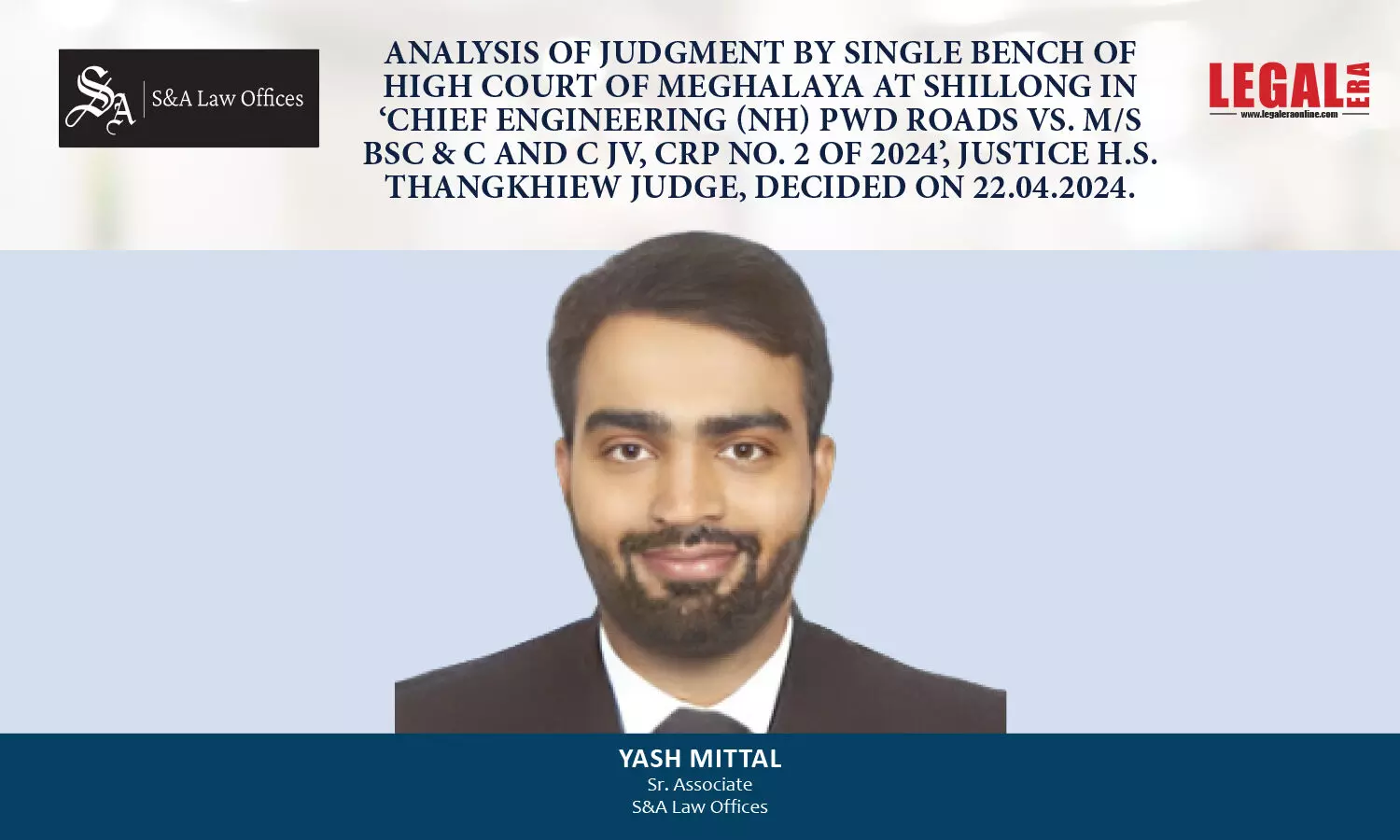- Home
- News
- Articles+
- Aerospace
- Artificial Intelligence
- Agriculture
- Alternate Dispute Resolution
- Arbitration & Mediation
- Banking and Finance
- Bankruptcy
- Book Review
- Bribery & Corruption
- Commercial Litigation
- Competition Law
- Conference Reports
- Consumer Products
- Contract
- Corporate Governance
- Corporate Law
- Covid-19
- Cryptocurrency
- Cybersecurity
- Data Protection
- Defence
- Digital Economy
- E-commerce
- Employment Law
- Energy and Natural Resources
- Entertainment and Sports Law
- Environmental Law
- Environmental, Social, and Governance
- Foreign Direct Investment
- Food and Beverage
- Gaming
- Health Care
- IBC Diaries
- In Focus
- Inclusion & Diversity
- Insurance Law
- Intellectual Property
- International Law
- IP & Tech Era
- Know the Law
- Labour Laws
- Law & Policy and Regulation
- Litigation
- Litigation Funding
- Manufacturing
- Mergers & Acquisitions
- NFTs
- Privacy
- Private Equity
- Project Finance
- Real Estate
- Risk and Compliance
- Student Corner
- Take On Board
- Tax
- Technology Media and Telecom
- Tributes
- Viewpoint
- Zoom In
- Law Firms
- In-House
- Rankings
- E-Magazine
- Legal Era TV
- Events
- Middle East
- Africa
- News
- Articles
- Aerospace
- Artificial Intelligence
- Agriculture
- Alternate Dispute Resolution
- Arbitration & Mediation
- Banking and Finance
- Bankruptcy
- Book Review
- Bribery & Corruption
- Commercial Litigation
- Competition Law
- Conference Reports
- Consumer Products
- Contract
- Corporate Governance
- Corporate Law
- Covid-19
- Cryptocurrency
- Cybersecurity
- Data Protection
- Defence
- Digital Economy
- E-commerce
- Employment Law
- Energy and Natural Resources
- Entertainment and Sports Law
- Environmental Law
- Environmental, Social, and Governance
- Foreign Direct Investment
- Food and Beverage
- Gaming
- Health Care
- IBC Diaries
- In Focus
- Inclusion & Diversity
- Insurance Law
- Intellectual Property
- International Law
- IP & Tech Era
- Know the Law
- Labour Laws
- Law & Policy and Regulation
- Litigation
- Litigation Funding
- Manufacturing
- Mergers & Acquisitions
- NFTs
- Privacy
- Private Equity
- Project Finance
- Real Estate
- Risk and Compliance
- Student Corner
- Take On Board
- Tax
- Technology Media and Telecom
- Tributes
- Viewpoint
- Zoom In
- Law Firms
- In-House
- Rankings
- E-Magazine
- Legal Era TV
- Events
- Middle East
- Africa

Analysis Of Judgment By Single Bench Of High Court Of Meghalaya At Shillong In ‘Chief Engineering (NH) PWD Roads Vs. M/s BSC & C And C JV, CRP No. 2 of 2024’, Justice H.S. Thangkhiew Judge, Decided On 22.04.2024.
Analysis Of Judgment By Single Bench Of High Court Of Meghalaya At Shillong In ‘Chief Engineering (NH) PWD Roads Vs. M/s BSC & C And C JV, CRP No. 2 of 2024’, Justice H.S. Thangkhiew Judge, Decided On 22.04.2024.

Analysis Of Judgment By Single Bench Of High Court Of Meghalaya At Shillong In ‘Chief Engineering (NH) PWD Roads Vs. M/s BSC & C And C JV, CRP No. 2 of 2024’, Justice H.S. Thangkhiew Judge, Decided On 22.04.2024. Issue Decided: - Principal Civil Courts empowered to extend mandate or replace Arbitrator, if not initially appointed by HC or SC. Facts of the Case 1. The Parties in...
To Read the Full Story, Subscribe to Legal Era News
Access Exclusive Legal Era Stories, Editorial Insights, and Expert Opinion.
Already a subscriber? Sign in Now
Analysis Of Judgment By Single Bench Of High Court Of Meghalaya At Shillong In ‘Chief Engineering (NH) PWD Roads Vs. M/s BSC & C And C JV, CRP No. 2 of 2024’, Justice H.S. Thangkhiew Judge, Decided On 22.04.2024.
Issue Decided: - Principal Civil Courts empowered to extend mandate or replace Arbitrator, if not initially appointed by HC or SC.
Facts of the Case
1. The Parties in the present case were the Chief Engineer (NH) PWD (Roads), Government of Meghalaya (hereinafter referred as the ‘Petitioner’) and M/s BSC&C & C JC (hereinafter referred as the ‘Respondent’). Due to the Arbitral Tribunal’s failure to render the award within the stipulated time and its subsequent extension, the Respondent applied for an extension of Arbitral Tribunal’s mandate under Section 29A of the Arbitration & Conciliation Act, 1996 (hereinafter referred as ‘A&C Act’) before the Commercial Court, East Khasi Hills (hereinafter referred as ‘Commercial Court’).
2. Subsequently, the Petitioner filed an application under Section 11 of the Commercial Courts Act read with Order 7 Rule 11, CPC 1908, Challenging the jurisdiction of the Commercial Court to entertain an application under Section 29A of A&C Act.
3. The Commercial Court ruled ‘that it had the jurisdiction to entertain the application for extending the mandate of the Arbitral Tribunal under Section 29A of the A&C Act’. Consequently, the Petitioner filed a revision application before the High Court of Meghalaya (hereinafter referred as ‘High Court’).

4. The two major issues that were raised by the Petitioner before the High Court are: - (i) Whether expression ‘Court’ used in Section 29A would mean the High Court or the Principal Civil Court in a District; (ii) Interpretation of the expression ‘Court’ as given in Sub-sections (4), (5) & (6) of Section 29A of the A&C Act.
5. Petitioner Argument - The Petitioner argued that the Ld. Commercial Court erred in interpreting the term ‘Court’ as the Principal Civil Court under Section 2 (1)(e) of the A&C Act. It was submitted that the power to extend a mandate is inherently tied to the Authority designated to appoint an Arbitrator. According to Section 29A (6) of the A&C Act, the Court has the authority to replace one or all arbitrators while extending the mandate, a power that resides exclusively with the High Court under Section 11 (6) of the A&A Act. Therefore, the term ‘Court’ in Section 29A cannot refer to Principal Civil Court in a district court as defined in Section 2(1)(e) of the A&C Act. Additionally, Section 2 of the A&C Act is preceded with the phrase ‘unless the context otherwise requires’, suggesting that ‘Court’ refers to the Principal Civil Court only if the context does not specify otherwise.
6. The Petitioner further argued that Section 29A (6) clearly indicates the term ‘Court’ implies the High Court, which alone holds the Authority to appoint Arbitrators in the context of domestic arbitration. To avoid incongruous outcomes, interpretation must ensure that only the High Court, not the District Court, is vested with the power to appoint new arbitrators as per Section 11 of the A&C Act.
7. Respondent Counter Argument – The Respondent submitted that the term ‘Court’ in Section 2(1)(e) of the A&C Act, when read alongside Section 29A (4), refers to the Principal Civil Court of original jurisdiction in a District, which includes the High Court, but only when exercising ordinary civil jurisdiction. However, since the High Court of Meghalaya doesn’t have ordinary civil jurisdiction, ‘Court’ in Section 29A refers specifically to the Principal Civil Court. Further, the definition of Court in Section 2(1)(e) is explicit, including the High Court only when it exercises original jurisdiction. The argued that the Supreme Court has clarified unless the context otherwise requires, the definition provided in Section should prevail. Therefore, under Section 11 of the Act, ‘Court’ means the High Court or the Supreme Court, implying the inclusion of the High Court only where expressly indicated, such as in Sections 11, 47 & 56 of the A&C Act.
8. The Respondent submitted that Section 29A was introduced alongside existing Section 11 and 2(1)(e) of the Act, implying consistency in legislative intent. Similarly, Section 34 grants courts power to set aside arbitral awards, regardless of the fact whether appointing authority is High Court or Supreme Court. Therefore, there’s no reasons arbitrators appointed by Higher Court’s cannot be substituted by the Principal Civil Court under Section 29A.
9. The High Court observed and upheld that Section 2(1)(e) defines the term ‘Court’ within the context of domestic arbitration, excluding international commercial arbitration. The legislative intent behind this provision is clear and requires no further elucidation. Further, even considering Section 29A (6), would demude the powers of the High Court not exercising original civil jurisdiction and would not come within the meaning of ‘Court’ as given in Section 2(1)(e) of the A&C Act. The term ‘Court’ used in Section 29A (4) is subject to interpretation with the provision “unless the context otherwise requires” allowing flexibility to understand definitions in accordance with surrounding context or specific circumstances. This provision grants courts the discretion to interpret the law in a manner that best serves the overall objectives of the statue, considering the intent of legislature and the broader context in which the operations operate.
10. Analyzing the term ‘Court’ in the A&C Act involves both contextual and textual interpretation respectively, balancing both ensures comprehensive application. Section 2(1)(e) allows the interpretation of the term ‘Court’ to be read keeping the objective of the statute intact and the same should not result in defeating the purpose, for which the provision i.e., Section 29A was inserted.
11. Referring to Magnum Opus IT Consulting Private Limited vs. Artcad Systems, through its Proprietor Vinay Digambar Shende (2022) SCC OnLine Bom 2861: (2023) 1 Arb LR 441, a distinction can be drawn if the Arbitrator is not appointed by the High Court under Section 11, the Commercial Court can extend the term under Section 29A. Since the High Court of Meghalaya lacks original Civil jurisdiction and Sections 11 & 29A (6) does not apply in the present case, the Commercial Court in Shillong being the Principal Court of original jurisdiction has jurisdiction to extend the mandate under Section 29A.
Disclaimer: This article was first published in the S&A Law Offices - 'Indian Legal Impetus' newsletter in May 2024.


